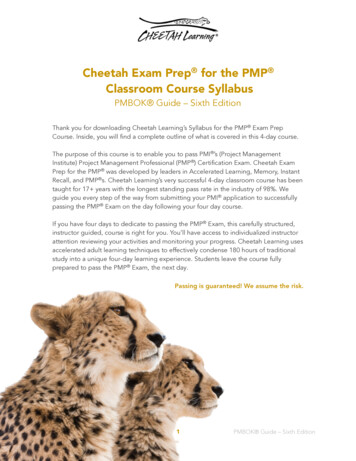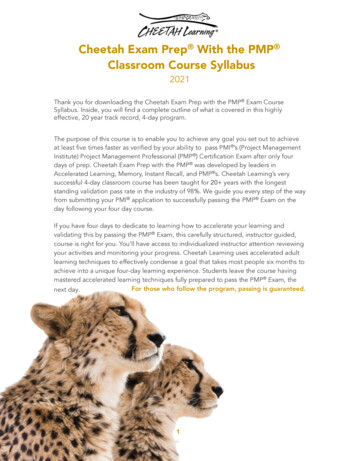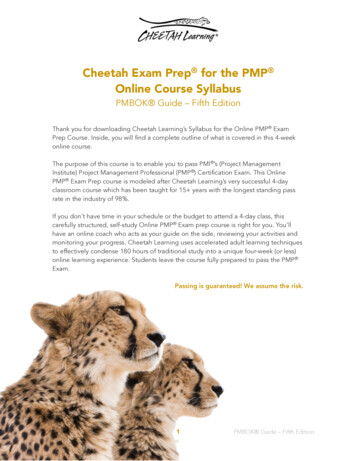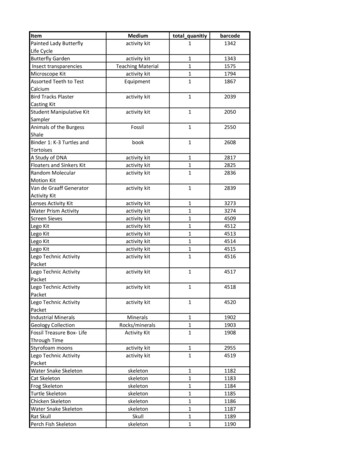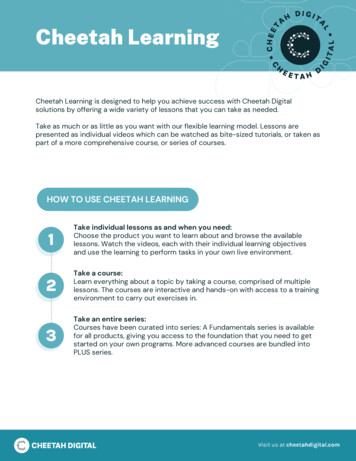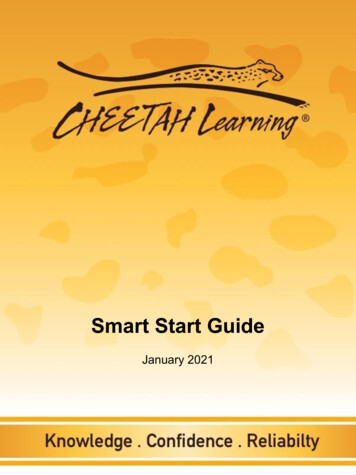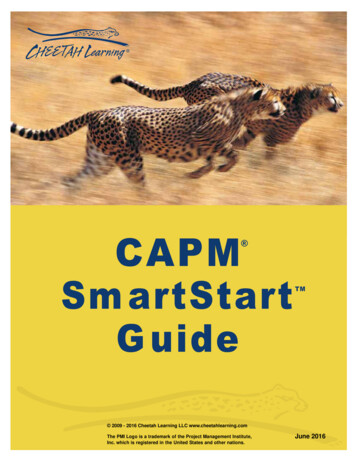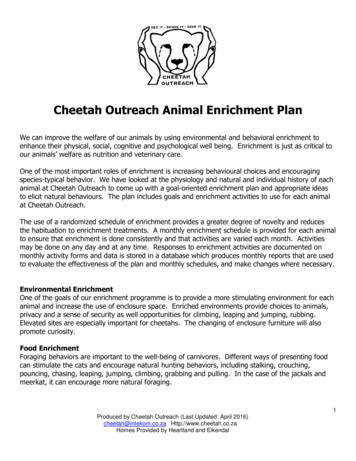
Transcription
Cheetah Outreach Animal Enrichment PlanWe can improve the welfare of our animals by using environmental and behavioral enrichment toenhance their physical, social, cognitive and psychological well being. Enrichment is just as critical toour animals’ welfare as nutrition and veterinary care.One of the most important roles of enrichment is increasing behavioural choices and encouragingspecies-typical behavior. We have looked at the physiology and natural and individual history of eachanimal at Cheetah Outreach to come up with a goal-oriented enrichment plan and appropriate ideasto elicit natural behaviours. The plan includes goals and enrichment activities to use for each animalat Cheetah Outreach.The use of a randomized schedule of enrichment provides a greater degree of novelty and reducesthe habituation to enrichment treatments. A monthly enrichment schedule is provided for each animalto ensure that enrichment is done consistently and that activities are varied each month. Activitiesmay be done on any day and at any time. Responses to enrichment activities are documented onmonthly activity forms and data is stored in a database which produces monthly reports that are usedto evaluate the effectiveness of the plan and monthly schedules, and make changes where necessary.Environmental EnrichmentOne of the goals of our enrichment programme is to provide a more stimulating environment for eachanimal and increase the use of enclosure space. Enriched environments provide choices to animals,privacy and a sense of security as well opportunities for climbing, leaping and jumping, rubbing.Elevated sites are especially important for cheetahs. The changing of enclosure furniture will alsopromote curiosity.Food EnrichmentForaging behaviors are important to the well-being of carnivores. Different ways of presenting foodcan stimulate the cats and encourage natural hunting behaviors, including stalking, crouching,pouncing, chasing, leaping, jumping, climbing, grabbing and pulling. In the case of the jackals andmeerkat, it can encourage more natural foraging.1Produced by Cheetah Outreach (Last Updated: April 2016)cheetah@intekom.co.za Http://www.cheetah.co.zaHomes Provided by Heartland and Eikendal
Sensory EnrichmentOlfactory enrichment can encourage investigation of smells, and resulting scent-marking, rubbing andgrooming. Visual enrichment can provide visual access to other animals and activities throughelevated sites.Novel EnrichmentIncreasing the diversity of natural behaviors can be accomplished through enrichment devices ornovel objects that can be manipulated by the animal. These objects promote exploration as well asnatural play and hunting behaviors.Social EnrichmentSocial groupings can encourage a whole repertoire of behavior that comes from living in a group,including social, territorial and courtship behaviors (this is especially important for male cheetahs).Social interaction with caretakers reduces stresses in captivity by building a positive relationship withhumans. Human interaction is particularly important for a social species like meerkats.ExerciseExercise through runs, walks and play encourages activity and maintains a healthy physical condition,as well as providing mental stimulation.Behavioral ConditioningBehavioral conditioning increases the intellectual focus of an animal. Animals choose to participate inthese sessions to maintain established or learn new behaviors. Behavioral conditioning can alsostrengthen the trust between handler and animal.2Produced by Cheetah Outreach (Last Updated: April 2016)cheetah@intekom.co.za Http://www.cheetah.co.zaHomes Provided by Heartland and Eikendal
Adult CheetahEnrichment Goals:1) Encourage activity through play and exercise2) Encourage natural play and hunting behaviors (stalking, chasing, running, chewing) throughfood and novel enrichment, and exercise3) Encourage investigation of scents and consequential rubbing and scent-marking througholfactory enrichment4) Increase visual stimulation through elevated sitesCurrent Enrichment:Environmental1) Hut with straw for shelter and privacy2) Shade area with thatched roof or shade cloth3) Platforms/large wooden boxes4) Scattered logs5) Large exercise enclosureFood1)2)3)4)5)6)7)8)9)Whole or partial large carcasses (horse or wild game)Whole or partial rabbitsLarge bonesMeat with fur on itRaw horse or wild game skinBloodsicles with pieces of meat insideRaw eggsMeat in watermelonsMeat inside papier-mâché balls or boxesSensory1) Spending time in running enclosure2) Switching enclosures with other cheetahs3) Visual contact with other cheetahs, small carnivores and dogs4) Walking other animals next to enclosures5) Straw from other cheetah or small predator enclosures6) BrushingNovel1) Boomer and soccer balls2) Cardboard prey animal3) Mop3Produced by Cheetah Outreach (Last Updated: April 2016)cheetah@intekom.co.za Http://www.cheetah.co.zaHomes Provided by Heartland and Eikendal
Social1) Interaction with other adult cheetahs and cubs through fence2) Interaction with staff and volunteers3) Interaction with the public through encounters, walks and functionsExercise1) Runs2) Walks on harness and lead3) Chasing plastic bottle or bird wing attached to whipBehavioral Conditioning1) Target and station training (with voice commands, signals and/or clicker)2) Harness and lead training3) Jumping on objects and sitting on command4) Venue training (inside and outside)5) Transportation (loading and travelling in vehicles)6) Crate training (for visits to the vet, travel and in case of emergency)4Produced by Cheetah Outreach (Last Updated: April 2016)cheetah@intekom.co.za Http://www.cheetah.co.zaHomes Provided by Heartland and Eikendal
Cheetah CubsEnrichment Goals:1) Encourage activity through play and exercise2) Encourage natural play and hunting behaviors (stalking, chasing, running, chewing) throughfood and novel enrichment, and exercise3) Encourage socialization with humans through bonding with handlers and volunteers4) Prepare for ambassadorial duties through behavioral conditioningCurrent Enrichment:Environmental1) Hut with straw for shelter and privacy2) Thatched shelter for shade and protection from rain and wind3) Platforms/large wooden boxes4) Splash pool (during summer)5) Large exercise enclosureFood1)2)3)4)5)6)7)Meat with fur on itParts of rabbit with furLarge bonesBloodsicles with pieces of meat insideRaw eggsMeat inside watermelonsMeat inside papier-mâché balls or boxesSensory1) Spending time in running enclosure2) Spending time in other cheetah enclosures3) Visual contact with other cheetahs, small carnivores and dogs4) Walking other animals next to enclosureNovel1)2)3)4)5)6)7)8)Plastic bottles, rubber/plastic balls and toys in splash poolBalls, Kong toys, rope toys and fire hose toysToys/balls hung from bungee cordOstrich feathersCardboard boxesCardboard prey animalFlying disc made of cardboardPapier-mâché balls5Produced by Cheetah Outreach (Last Updated: April 2016)cheetah@intekom.co.za Http://www.cheetah.co.zaHomes Provided by Heartland and Eikendal
Social1) Interaction with cheetahs through fence2) Interaction with staff and volunteers3) Interaction with the public through encounters, walks and functionsExercise1) Runs2) Walks on harness and lead3) Chasing plastic bottle, bird wing, animal hide or other toys attached to whipBehavioral Cconditioning1) Target and station training (with voice commands, signals and/or clicker)2) Harness and lead training3) Jumping on objects and sitting on command4) Venue training (inside and outside)5) Transportation (loading and travelling in vehicles)6) Crate training (for visits to the vet, travel and in case of emergency)6Produced by Cheetah Outreach (Last Updated: April 2016)cheetah@intekom.co.za Http://www.cheetah.co.zaHomes Provided by Heartland and Eikendal
ServalsEnrichment Goals:1) Encourage activity through play and exercise2) Encourage natural play and hunting behaviors (stalking, chasing, pouncing, leaping, grabbing)through food and novel enrichment3) Encourage investigation of scents, rubbing, marking and grooming through olfactoryenrichmentCurrent Enrichment:Environmental1) Hut with straw for shelter and privacy2) Scattered logs, climbing limbs and branches3) Patches of tall grass and vegetation4) Platforms5) Underground burrow6) Splash poolFood1) Whole or partial wild game carcasses2) Pieces of rabbit with fur3) Meat with fur on it4) Large bones5) Whole or partial birds with feathers6) Whole rats and mice7) Baby chicks8) Raw eggs9) Scattering meat on logs and platforms10) Throwing pieces of meat in air11) Hanging meat from pole12) Meat inside long tube or box with holes13) Fish/meat inside watermelon14) Fish/meat/mice in papier-mâché balls15) Fish/meat inside rubber ball with holes or in Kong toy16) Fish/meat/mice in water in splash pool17) Foraging for snakes, lizards, frogs and mice on walksSensory1) Visual contact with cheetahs, other servals, caracal, jackals, bat-eared foxes, dogs2) Spending time in other enclosures3) Walking other animals next to enclosure4) Snake skin7Produced by Cheetah Outreach (Last Updated: April 2016)cheetah@intekom.co.za Http://www.cheetah.co.zaHomes Provided by Heartland and Eikendal
5)6)7)8)Novel1)2)3)4)5)6)7)8)9)10)Springbok hideFresh catmintRub fish gel on objectsBrushingSoft, rubber or rope toysToy hung from bungee cordBallsFeathersBags of leavesCardboard boxesRoll of toilet paperPlastic bottles, balls or other toys in splash poolBlowing bubbles into splash poolPlaying with water from hosepipe or sprinklerSocial1) Interaction with other serval, caracal, bat-eared foxes and dogs through fence2) Interaction with staff and volunteersExercise1) Walks2) Chasing and jumping for plastic bottle, toy, feather or bird wing attached to whipBehavioral Conditioning1) Target and station training (with voice commands, signals and/or clicker)2) Harness and lead training3) Jumping on objects and sitting on command4) Venue training (inside and outside)5) Transportation (loading and travelling in vehicles)6) Crate training (for visits to the vet, travel and in case of emergency)8Produced by Cheetah Outreach (Last Updated: April 2016)cheetah@intekom.co.za Http://www.cheetah.co.zaHomes Provided by Heartland and Eikendal
CaracalEnrichment Goals:1) Encourage activity through play and exercise2) Encourage natural play and hunting behaviors (stalking, chasing, pouncing, leaping, jumpingand climbing) through food and novel enrichment3) Encourage investigation of scents, rubbing, marking and grooming through olfactoryenrichmentCurrent Enrichment:Environmental1) Hut with straw for shelter and privacy2) Scattered logs and climbing limbs3) Patch of tall grass4) Platforms5) Moveable small dog house6) Empty splash pool with branchesFood1) Whole or partial wild game carcasses2) Whole squirrels with fur3) Meat with fur on it4) Large bones5) Large bone on a bungee feeder6) Whole or partial birds with feathers7) Whole rats and mice8) Baby chicks9) Bloodsicles with pieces of meat or mouse inside10) Large bloodsicle with rope hung on bungee feeder11) Raw eggs12) Scattering meat on logs, branches and platforms13) Hanging meat, mice, baby chicks from poles14) Meat inside watermelon15) Meat inside boxes or papier-mache ballsSensory1) Visual contact with cheetahs, servals, jackals and dogs2) Walking other animals next to enclosure3) Spending time in other enclosure4) Brushing9Produced by Cheetah Outreach (Last Updated: April 2016)cheetah@intekom.co.za Http://www.cheetah.co.zaHomes Provided by Heartland and Eikendal
Novel1)2)3)4)5)Soft, rope, rubber or Kong toysBallsCardboard boxesMopBlanketSocial1) Interaction with jackals and servals through fence, and with other animals while on walks2) Interaction with staff and volunteers3) Interaction with the public during encounters and on walksExercise1) Walks2) Chasing whip with plastic bottle, Kong toy, feathers or bird wingBehavioral Conditioning1) Target and station training (with voice commands, signals and/or clicker)2) Harness and lead training3) Jumping on objects and sitting on command4) Venue training (inside and outside)5) Transportation (loading and travelling in vehicles)6) Crate training (for visits to the vet, travel and in case of emergency)10Produced by Cheetah Outreach (Last Updated: April 2016)cheetah@intekom.co.za Http://www.cheetah.co.zaHomes Provided by Heartland and Eikendal
Black-backed JackalsEnrichment Goals:1) Encourage activity through play and exercise2) Encourage natural play and hunting behaviors (chasing, pouncing, foraging) through food andnovel enrichment3) Encourage investigation of scents, rubbing, and marking through olfactory enrichmentCurrent Enrichment:Environmental1) Hut with straw for shelter and privacy2) Scattered logs and branches3) Patches of tall grass4) PlatformFood1) Whole or partial wild game carcasses2) Pieces of rabbit with fur/rabbit heads3) Meat with fur on it4) Raw horse or wild game skin5) Large bones6) Whole or partial birds with feathers7) Whole rats and mice8) Baby chicks9) Grubs or meal worms buried in dirt10)Bloodsicles with pieces of meat or mice inside11) Raw or hardboiled eggs12) Peanut butter or honey on logs and trees (small amounts)13) Peanuts (raw and in shells)14) Scattering meat, pellets and fruit soaked in blood around enclosure15) Hiding small pieces of meat/sardines in piles of logs and under bark of tree16) Throwing pieces of meat, peanuts or dog pellets in air17) Meat inside watermelon or pumpkin18) Meat in paper towel rolls, papier-mache balls or boxes19) Meat and fruit in pine conesSensory1) Visual contact with caracal, meerkats, cheetahs and dogs2) Spending time in other enclosures3) Walking other animal next to enclosure4) Rawhide/dried pig ears5) Rub fish gel on objects11Produced by Cheetah Outreach (Last Updated: April 2016)cheetah@intekom.co.za Http://www.cheetah.co.zaHomes Provided by Heartland and Eikendal
6) Straw from other enclosures7) Other animal feces (baked first)Novel1) Boomer ball2) Cardboard boxesSocial1) Interaction with other jackal2) Interaction with caracal through fence, and with servals and meerkats on walks3) Interaction with staff and volunteersExercise1) Walk on leads2) Chasing bird wing on whip or feather duster (outside fence)Behavioral Conditioning1) Collar and lead training2) Station holding (holding on platform during feeding)12Produced by Cheetah Outreach (Last Updated: April 2016)cheetah@intekom.co.za Http://www.cheetah.co.zaHomes Provided by Heartland and Eikendal
Bat-eared FoxesEnrichment Goals:1) Encourage activity through play and exercise2) Encourage natural play and foraging behaviors (chasing, pouncing, digging) through food andnovel enrichment3) Encourage investigation of scents, rubbing, and marking through olfactory enrichmentCurrent Enrichment:Environmental1) Shelter with straw for shelter and privacy2) Moveable small dog house3) Scattered logs4) Area for digging burrowsFood1) Live insects2) Dried mealworms3) Whole mice/unborn rats4) Baby chicks5) Meat with fur on it6) Bones7) Bloodsicles with meat or mice inside8) Raw eggs9) Honey on logs and trees (small amounts)10)Whole fruits and vegetables11) Peanuts (raw and in shells)12) Scattering food around enclosure13) Hiding food in piles of logs and under bark14) Burying insects in sandbox15) Food inside basket feeder16) Food inside puzzle feeder17) Food inside papier-mache balls18) Meat and fruit in pine conesSensory1) Visual contact with caracal, servals and dogs2) Walking other animal next to enclosure3) Spending time in other enclosure4) Fresh catmint or parsley5) Dried catnip on a blanket6) Straw from other enclosures13Produced by Cheetah Outreach (Last Updated: April 2016)cheetah@intekom.co.za Http://www.cheetah.co.zaHomes Provided by Heartland and Eikendal
7) Springbok hideNovel1)2)3)4)5)6)Soft, rubber and rope toysBallsLightweight plastic balls in splash pool with treats buried underneathWhip and toys/feathers/plastic bottleFeather dusterCardboard boxesSocial1) Interaction with other bat-eared foxes2) Interaction with servals and dogs through fence, and with caracal and meerkats on walks3) Interaction with staff and volunteersExercise1) Chasing whip with Kong toy, soft toys, feathers or bird wing2) Jumping for chicks/mice on sticksBehavioral Conditioning1) Target and station training (with voice commands, signals and/or clicker)2) Harness and lead training3) Crate training (for visits to the vet, travel and in case of emergency)14Produced by Cheetah Outreach (Last Updated: April 2016)cheetah@intekom.co.za Http://www.cheetah.co.zaHomes Provided by Heartland and Eikendal
MeerkatsEnrichment Goals:1) Encourage activity through walks2) Encourage natural behaviors (foraging, digging) through food enrichment and walks3) Encourage investigation of scents, rubbing, and marking through olfactory enrichment andwalks4) Encourage social behaviors through interaction with caretakersCurrent Enrichment:Environmental1) Den2) Vegetation3) Mounds and artificial tunnels4) Logs and platforms5) VegetationFood1) Live insects2) Dried mealworms3) Whole mice/unborn rats4) Baby chicks5) Meat with fur on it6) Bones7) Bloodsicles with meat or mice inside8) Raw eggs9) Whole fruits and vegetables10) Peanuts (raw and in shells)11) Honey on logs and branches (small amounts)12) Scattering food around enclosure13) Stuffing food in holes and crevices in logs and under bark14) Food inside watermelons, pumpkins or squash15) Food inside basket feeder16) Food inside puzzle feeder17) Food inside treat balls, papier-mache balls or in toilet paper rolls18) Meat and fruit in pine cones19)Foraging during walks and in other enclosures (turning over logs and rocks to expose insectsand other prey)Sensory1) Visual contact with jackals, dogs and rabbits15Produced by Cheetah Outreach (Last Updated: April 2016)cheetah@intekom.co.za Http://www.cheetah.co.zaHomes Provided by Heartland and Eikendal
2)3)4)5)Walking other animals next to enclosureSpending time in other enclosureFresh herbs (parsley, coriander, sage)Springbok hideNovel1) Soft toys2) Whip and feathers3) Lightweight plastic balls in splash pool with treats underneathExercise1) Walks2) Spending time in larger enclosure3) Chasing whip with feathers or toys4) Jumping for chicks/mice on sticksSocial1) Interaction with other meerkat2) Interaction with servals, caracal, jackals, bat-eared foxes, dogs and cheetahs through fenceduring walks3) Interaction with staff and volunteersBehavioral Conditioning4) Target and station training (with voice commands, signals and/or clicker)5) Harness and lead training6) Jumping on objects and sitting on command7) Venue training (inside and outside)8) Crate training (for visits to the vet, travel and in case of emergency)16Produced by Cheetah Outreach (Last Updated: April 2016)cheetah@intekom.co.za Http://www.cheetah.co.zaHomes Provided by Heartland and Eikendal
Enrichment Precautions and Restrictions All animal skins and bones are given within 30 minutes of feeding.Bloodsicles are limited to 2 per animal per month.Fish is thawed before using.Chicks are de-yolked before giving to animals.No grapes, raisins or cranberries are given to any of our animals.Only small amounts of honey, peanut butter or peanuts are given.Fruits and vegetables high in sugar are avoided.Other animal feces are sterilized before use.No loose toys or novel objects are left in enclosures without supervision.17Produced by Cheetah Outreach (Last Updated: April 2016)cheetah@intekom.co.za Http://www.cheetah.co.zaHomes Provided by Heartland and Eikendal
animal at Cheetah Outreach to come up with a goal-oriented enrichment plan and appropriate ideas to elicit natural behaviours. The plan includes goals and enrichment activities to use for each animal . Target and station training (with voice commands, signals and/or clicker) 2) Harness and lead training 3) Jumping on objects and sitting on .

